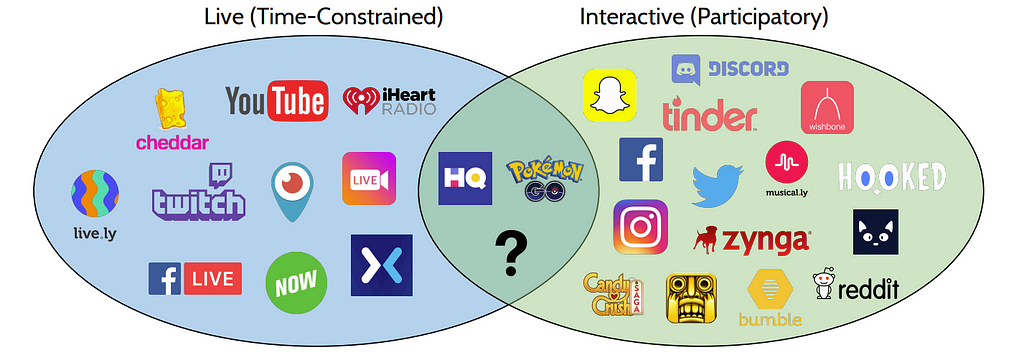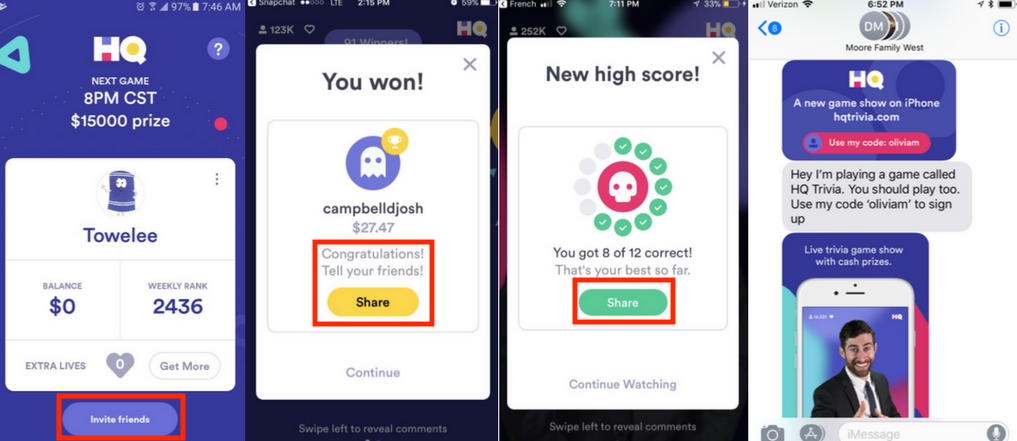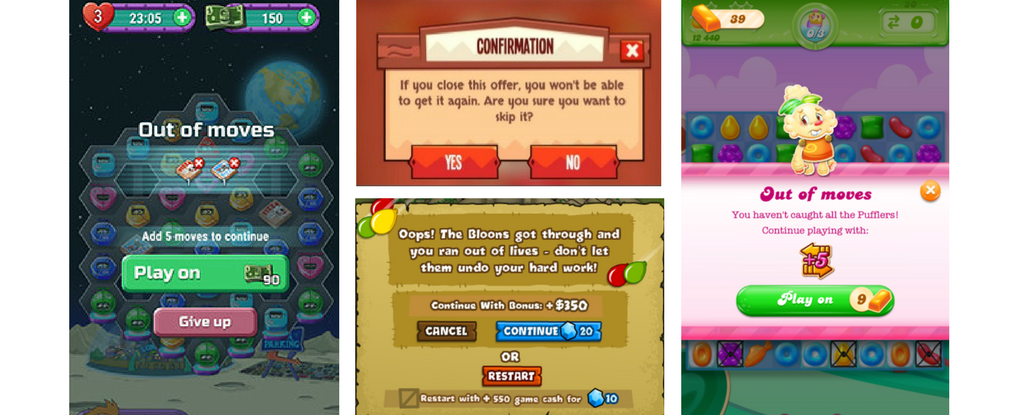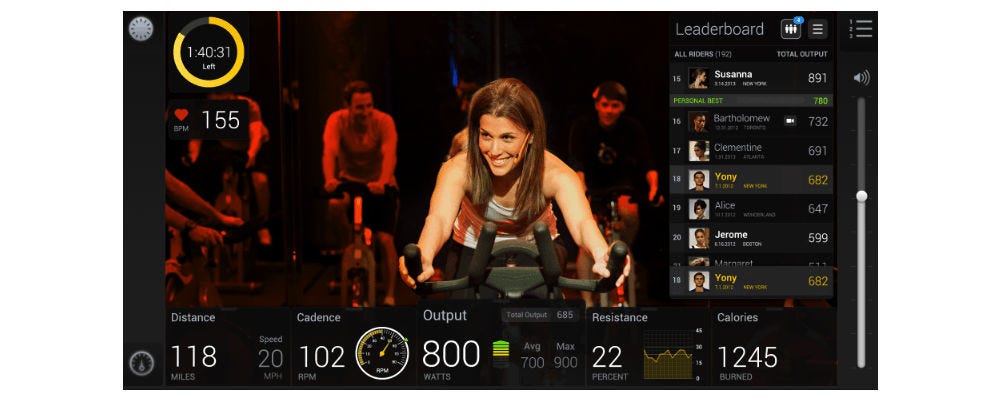Latest news about Bitcoin and all cryptocurrencies. Your daily crypto news habit.
We believe it’s time for a new wave of mobile experiences.
The apps that currently dominate the charts are great at serving up content to kill time — you can watch a stream of your favorite gamer on Twitch, scroll through pictures on Instagram, or struggle through levels of Candy Crush. While these experiences can be entertaining, they are inherently isolating. Even “interacting” with others through liking or commenting on a post is an asynchronous experience. You aren’t communicating with someone in real time, but instead adding another layer to a feed of static content.
We see a big opportunity to take advantage of the true magic of smartphones: the ability to connect anyone, anywhere, in real time to enable live and shared experiences. These experiences will be time-constrained and synchronous (they happen at a specific time, with everyone playing at once), as well as meaningfully participatory (everyone can contribute in a way that impacts the overall experience). We see this as innately more compelling and “sticky” than much of what we see on mobile now, as these experiences create excitement and a sense of FOMO that static content can’t compete with.
 We think the next wave of compelling mobile experiences will come at the intersection of live and interactive. The diagram above does not include video chat apps like Houseparty or Marco Polo, which we see more as communication (chatting with friends) than entertainment (broadcasting content for others).
We think the next wave of compelling mobile experiences will come at the intersection of live and interactive. The diagram above does not include video chat apps like Houseparty or Marco Polo, which we see more as communication (chatting with friends) than entertainment (broadcasting content for others).
A few examples of early implementations of this live and interactive trend, both in mobile and traditional media and gaming:
- HQ Trivia — HQ is seeing upwards of 1M players per game on no marketing spend, and has become a cultural phenomenon. While a big part of the thrill is finally being in the contestant seat on a Jeopardy-like game, the lure of live is equally important. Competitor The Cash Show, which is broadcast more often and gives out larger prizes, is a much less compelling user experience as it’s pre-recorded. There’s a thrill in knowing the content is made in real time, and your participation could influence the game.
- Livestreaming apps — Meipai, Inke, YY, and other broadcasting apps have skyrocketed to success in China, with nearly half of Internet users watching a livestream by the end of 2016. Popular streamers make thousands of dollars a month through digital gifts sent by viewers who want to be acknowledged. These apps are definitely “live”, but it’s hard to argue that they’re truly interactive — with hundreds of thousands of users in a crowded comment section, meaningful participation is limited.
 Chinese livestreaming apps allow anyone from normal teens to celebrities to broadcast their lives online and get digital gifts from fans.
Chinese livestreaming apps allow anyone from normal teens to celebrities to broadcast their lives online and get digital gifts from fans.
- Reddit AMAs — arguably one of the most popular Reddit features, the AMA subreddit has 17M subscribers. Past AMAs have featured Tony Hawk, Barack Obama, Mark Cuban, and Al Gore. AMAs are both live (the interviewee is online for an hour or so, and answers questions in real time) and interactive (users submit their own content and get a chance to engage with the interviewee). While many users will have their questions go unanswered, even a tiny chance of getting to interact with the interviewee is enough to motivate 20k+ posts on a single thread.
- Pokemon Go — in just a year post-launch, Pokemon Go passed $1.2B in revenue and 750M downloads. The breakaway success of the app can be partially attributed to its interactivity — for the first time, anyone could become a Pokemon trainer — but a “live” component also played a big role. Sightings of rare Pokemon that caused users to flood parks created a sense of urgency that kept people engaged.
Why mobile, and why now?
Though smartphones seem nearly ubiquitous now, they are actually fairly new — 2014 was the first year when more than 50% of Americans owned smartphones, according to Statista. Why is mobile the key to enabling these live and interactive experiences? We have a few ideas:
- Notifications. Push notifications create the FOMO feeling that entices users. It’s easy to put off reading your Twitter feed, but much harder to resist watching a show or game that only happens once a day, especially when your phone prompts you to open the app.
- Catch users where they are. Given that most people carry their phones everywhere, mobile is the clear choice for capturing the largest number of potential users at a given time. A sizable audience is needed to make live, synchronous, interactive experiences work, which we’ll discuss below.
- Interactivity. Mobile allows users to interact with content in a nearly frictionless way. Imagine if you had to use your TV remote to answer HQ Trivia questions — only one or two people per household could play at once. Mobile creates a unique opportunity for everyone to have their own remote, and all viewers can participate in and shape the experience.
- Social integrations. Most apps let users seamlessly share download links via SMS and social platforms, which is a huge benefit when it comes to spreading the word. You probably aren’t going to take a photo of your TV and send it to someone, or even go to the effort of sending a URL over email, but you might hit one button to text a download link to your friends.
 At various points in the game, HQ prompts you to share your score and invite friends to play. The app also makes it easy to send a referral code via social media or SMS.
At various points in the game, HQ prompts you to share your score and invite friends to play. The app also makes it easy to send a referral code via social media or SMS.
- Payments. Many of us have added credit card info on our phones to make purchases easy, allowing us to bypass long forms and verifications for in-app purchases. If you’re eliminated on Q11 on HQ Trivia, will you be able to resist buying an extra life for $0.99 with one click? We think this will benefit mobile platforms when it comes to monetization.
What we’re looking for
As we think about which companies will define the future of this space, we’re excited by platforms with the following characteristics:
- Sense of loss aversion. Studies have shown that people hate losing even more than they love winning. Advertisers and game designers use this to compel people to spend more money or time on their products, which explains why you used to log into Farmville five times a day to water your crops. Synchronous, interactive experiences have a unique ability to leverage users’ inherent loss aversion to create a strong repeat usage. You could always chose not to join your favorite Internet celebrity’s broadcast, but what if today is the day that (s)he finally notices your comment?
 Mobile games use the principle of loss aversion to get users to buy more lives or tokens — if you don’t keep playing the game, you’ll lose all the progress you made!
Mobile games use the principle of loss aversion to get users to buy more lives or tokens — if you don’t keep playing the game, you’ll lose all the progress you made!
- Evolving experience. To build a lasting business in this space, it’s crucial to create an experience that evolves over time. Game designer Amy Jo Kim describes this as “creating a path to mastery” — as the user spends more time on the platform, the experience should improve and he or she should be able to unlock more functionality. We see this as an area where HQ Trivia could improve. Instead of just having one game for everyone, players could unlock subject-specific games (e.g. sports, pop culture) by demonstrating mastery in those subjects. This would give players an objective to aim for and make the game experience more fresh.
- Unique forms of interactivity. Being able to like or comment on content is old news, and we think the novelty of “tipping” livestreamers will soon wear off. We’re most excited about companies that integrate these traditional forms of interaction while also creating new ways for users to be involved in building a true experience. Pokemon Go is a great example of this, as it incentivized millions of users to leave their homes and catch Pokemon in the real world. We know there are other opportunities for apps to engage their users in new and creative ways — what if a fitness instructor could stream a live class to thousands of people worldwide, and showcase real-time videos of participants with the best form?
 Many users love that the leaderboard in Peloton’s live classes allows them to see how they stack up against other riders worldwide. We’re excited to see how Peloton continues to evolve this live experience.
Many users love that the leaderboard in Peloton’s live classes allows them to see how they stack up against other riders worldwide. We’re excited to see how Peloton continues to evolve this live experience.
Challenge in scaling an audience
The obvious challenge of live and interactive platforms is how to scale the number of participants while maintaining high quality content. Users want to feel like they are part of a big group — it’s not exciting and is slightly awkward to be one of a few people watching an Instagram livestream, for example. However, most users are unwilling to slog through poor quality or spammy content generated by thousands or even millions of other users.
This is a core problem for social networks, which has led to the rise of influencers. The bulk of the content on platforms like YouTube, Snapchat, Instagram is actually fairly low quality, and engagement is dominated by a small number of high-skill users. It’s relatively easy for these platforms to manage this because they are non-live — YouTube doesn’t have to decide to whether or not to feature your content while you are making your first video. The platform can watch the views, likes, and comments that you get and then start promoting your videos over time.
Live platforms don’t have this advantage, as the “director” of the experience has to make real-time decisions about what user-generated content is worthy of being broadcast to all participants. Ideally, these decisions will be automated — it’s not scalable to build a huge team of people who can review every piece of content in real-time — but also extremely accurate, as it could be disastrous to broadcast inappropriate or simply irrelevant content to millions of users. The stakes are especially high if there is only one stream on the platform. Bored users are likely to just fully exit the app, unlike on YouTube or Instagram where they can easily click to watch something else.
Admittedly, this is a problem we don’t yet have a perfect solution to. We suspect that the next wave of live, interactive platforms will have to somehow connect users to their real identities (to dis-incentivize bad behavior), automate content moderation, and potentially make users overcome certain barriers to earn the right to broadcast content (such as Reddit’s “karma”). However, we are confident that companies in this space will come up with creative solutions to this problem — if you are building something innovative in this space, let us know!
Thanks to Saar Gur for his feedback and contributions to this article!
Thanks for reading! We’d love your thoughts and feedback, and please let us know if you are working on something in this space. You can reach us at justine@crv.com and olivia@crv.com, or on Twitter @venturetwins.
Zynga is dead: Long live the new wave of mobile entertainment was originally published in Hacker Noon on Medium, where people are continuing the conversation by highlighting and responding to this story.
Disclaimer
The views and opinions expressed in this article are solely those of the authors and do not reflect the views of Bitcoin Insider. Every investment and trading move involves risk - this is especially true for cryptocurrencies given their volatility. We strongly advise our readers to conduct their own research when making a decision.
